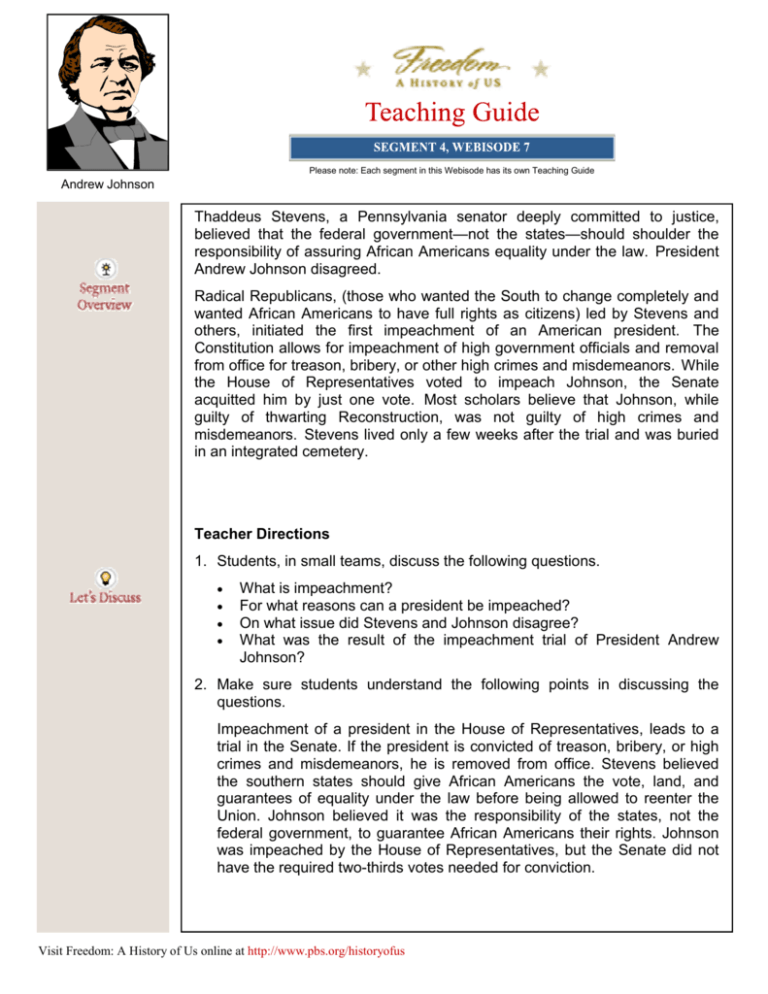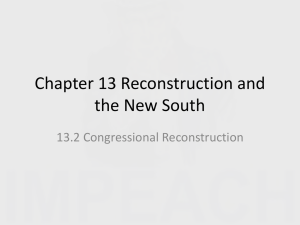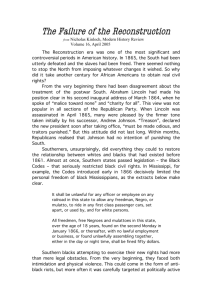
Please note: Each segment in this Webisode has its own Teaching Guide
Andrew Johnson
Thaddeus Stevens, a Pennsylvania senator deeply committed to justice,
believed that the federal government—not the states—should shoulder the
responsibility of assuring African Americans equality under the law. President
Andrew Johnson disagreed.
Radical Republicans, (those who wanted the South to change completely and
wanted African Americans to have full rights as citizens) led by Stevens and
others, initiated the first impeachment of an American president. The
Constitution allows for impeachment of high government officials and removal
from office for treason, bribery, or other high crimes and misdemeanors. While
the House of Representatives voted to impeach Johnson, the Senate
acquitted him by just one vote. Most scholars believe that Johnson, while
guilty of thwarting Reconstruction, was not guilty of high crimes and
misdemeanors. Stevens lived only a few weeks after the trial and was buried
in an integrated cemetery.
Teacher Directions
1. Students, in small teams, discuss the following questions.
•
•
•
•
What is impeachment?
For what reasons can a president be impeached?
On what issue did Stevens and Johnson disagree?
What was the result of the impeachment trial of President Andrew
Johnson?
2. Make sure students understand the following points in discussing the
questions.
Impeachment of a president in the House of Representatives, leads to a
trial in the Senate. If the president is convicted of treason, bribery, or high
crimes and misdemeanors, he is removed from office. Stevens believed
the southern states should give African Americans the vote, land, and
guarantees of equality under the law before being allowed to reenter the
Union. Johnson believed it was the responsibility of the states, not the
federal government, to guarantee African Americans their rights. Johnson
was impeached by the House of Representatives, but the Senate did not
have the required two-thirds votes needed for conviction.
Visit Freedom: A History of Us online at http://www.pbs.org/historyofus
Page 2 of 4
Segment 4, Webisode 7
Teacher Directions
1. Explain to students that to impeach means to charge a public official before
a governing, legislative body with misconduct while in office. Presidential
impeachment requires the charge of treason, bribery, or other high crimes
and misdemeanors.
2. Explain to students that most historians believe that Andrew Johnson was
impeached more for his political beliefs than for any high crimes or
misdemeanors. Southern states tried to circumvent the Thirteenth
Amendment (abolishing slavery) by passing Black Codes restricting the
lives of African Americans. Congress established the Freedmen’s Bureau
to protect the rights of the four million formerly enslaved African Americans.
Congress also passed the Civil Rights Act of 1866, which guaranteed
African Americans all the rights of citizenship and forbade states from
restricting their rights. Johnson vetoed the bill. (Under the Constitution, the
president can veto any bill passed by Congress; his veto can be overridden
by a two-thirds majority in both houses.) For the first time in American
history, Congress overrode a presidential veto. Congress went on to pass
other Reconstruction acts. When Johnson tried to fire Secretary of War
Edwin Stanton, a Radical Republican, the House of Representatives
impeached him.
3. Distribute the Student Sheet: The Impeachment of Andrew Johnson. With
teammates, students discuss the following questions.
•
•
•
Why is this cartoon called “The Veto”?
What is President Andrew Johnson doing?
What is the result of his actions?
4. Make sure students understand that Johnson’s veto of the Civil Rights Act
and his opposition to the Freedmen’s Bureau were factors in his
impeachment but were not grounds for a conviction.
Teacher Directions
In their small learning teams, students respond to one of the following
prompts.
•
•
Do you believe Thaddeus Stevens was a hero? Why or why not?
After the war, some Americans proposed that freed African American
slaves be given land to help them make a living and to pay them back
for slavery. Should African Americans have been given “forty acres and
a mule”?
Visit Freedom: A History of Us online at http://www.pbs.org/historyofus
Page 3 of 4
Segment 4, Webisode 7
Teacher Directions
1. Ask students the following question.
Have you ever heard the phrase “forty acres and a mule”? Or have you
ever heard someone say, “I want my forty acres and a mule”?
2. Introduce students to the concept of reparations for formerly enslaved
African Americans by sharing the following information.
Several plans were suggested or adopted to help the formerly enslaved
African Americans support themselves. Near the end of the Civil War,
during his March to the Sea, General William T. Sherman issued Special
Field Order # 15 on January 16, 1865, setting aside lands along the coast
of Charleston for African American settlements. The government would
distribute forty acres of land to each head of a family.
During Reconstruction, Radical Republican Senator Thaddeus Stevens
offered several plans to assist former slaves. Stevens wanted to break up
large Southern plantations to provide formerly enslaved African Americans
with land. His plan, viewed as too radical and punitive toward the South,
was not adopted. President Johnson vetoed any proposal that provided
land to freedmen.
The Southern Homestead Act of 1867 aimed to make public lands in the
South available to both blacks and whites. But most poor people lacked
even the small amount of money needed to buy land. Many free African
Americans became tenant farmers or sharecroppers. Under the
sharecropping system, the owner provided land, seed, and supplies. The
sharecropper worked the land and paid the owner with a share of the crops
he grew. Unfortunately, this system kept power—and capital—in the hands
of the owners, and virtually enslaved the sharecropper, who somehow
never got ahead financially.
3. Distribute the Student Sheet: Forty Acres and a Mule. In their small groups,
students discuss the following questions.
•
•
What was General Sherman’s plan to help freed African Americans?
What was Thaddeus Stevens’ plan?
Do you think Stevens’ plan should have been adopted? Why or why
not?
Visit Freedom: A History of Us online at http://www.pbs.org/historyofus
Page 4 of 4
Segment 4, Webisode 7
Teacher Directions
Use the following activities with your students.
Language Arts — Students write a storyboard for a play or skit that tells the
story of individual black Reconstruction legislators or of the impeachment of
Andrew Johnson.
Geography — Students draw a map of the United States that communicates
the dates or the order in which the former Confederate states adopted their
Reconstruction constitutions.
Visit Freedom: A History of Us online at http://www.pbs.org/historyofus
Impeaching a President
Harpers’s Weekly 1866
Webisode 7 Student Sheet
Segment 4, Page 1 of 2
© The Johns Hopkins University. All Rights Reserved.
For more information, visit Freedom: A History of US
Online at http://www.pbs.org/historyofus
Forty Acres and a Mule
The islands of Charleston south, the abandoned
rice fields along the rivers for thirty miles back
from the sea, and the country bordering St.
Johns River, Florida, are reserved and set apart
for the settlement of Negroes now made free by
the acts of war and the proclamation of the
President of the United States.”
Whenever respectable negroes, heads of families,
shall desire to settle on land ... each family shall
have a plot of not more than (40) forty acres of
tillable ground…
General William T. Sherman’s
Special Field Order # 15
Within a few months, 40,000 freedmen had received
400,000 acres of land. However, President Johnson
broke the promise made to the freedmen and ordered
the land returned to its original plantation owners.
Over the next few years, several other plans were
proposed to grant land to freedmen. Thaddeus
Stevens proposed that the government confiscate the
property of former slaveholders who owned more than
two hundred acres. This land would be
allocated to freedmen in forty-acre lots.
The remaining land would be sold and
part of the money used to pay
pensions of Union soldiers. This plan
was not approved.
Webisode 7 Student Sheet
Segment 4, Page 2 of 2
© The Johns Hopkins University. All Rights Reserved.
For more information, visit Freedom: A History of US
Online at http://www.pbs.org/historyofus





